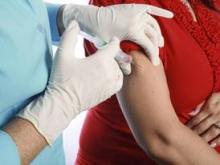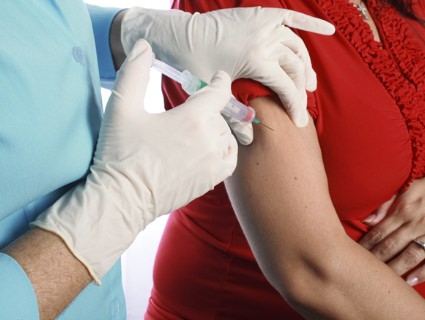User login
ACIP Backs Meningococcal Vaccine for High-Risk Infants Only
Infants at increased risk for meningococcal disease should receive four doses of the Hib-MenCY-TT vaccine at ages 2, 4, 6 months and between 12-15 months, according to the majority of the Centers for Disease Control and Prevention’s Advisory Committee on Immunization Practices.
At a meeting on Oct. 24, the committee voted 13-1, with one abstention, to support this proposal by ACIP’s meningococcal vaccines work group. Children at risk include those with recognized persistent complement pathway deficiencies and those with anatomic or functional asplenia including sickle cell disease. The vaccine also can be used in infants aged 2-18 months who live in communities with outbreaks of serogroup C and Y meningococcal disease, according to the proposal.
ACIP is not recommending routine meningococcal vaccination for infants.
The meningococcal groups C and Y and Haemophilus b tetanus toxoid conjugate vaccine (MenHibrix) was approved in June 2012 to prevent invasive disease caused by Neisseria meningitidis serogroups C and Y and Haemophilus influenzae type b in children aged 6 weeks through 18 months.
Current ACIP recommendations for routine meningococcal vaccination recommend vaccination at ages 11-12 years with a booster dose at age 16 years. For younger children, the schedule recommends one of the quadrivalent meningococcal conjugate vaccines for children at high risk including those with persistent complement component deficiency; the minimum age for Menactra (MenACWY-D) is 9 months and is 2 years for Menveo (MenACWY-CRM).
The work group considered two options: a recommendation for all infants or vaccination only or for those at increased risk for meningococcal disease, said Dr. Amanda Cohn, a medical officer in the CDC’s National Center for Immunization and Respiratory Diseases. The work group concluded that the data do not currently support routine infant meningococcal vaccination.
But the group recommended vaccination for high-risk infants, a small group (about 5,000 infants a year), who are a "feasible target for vaccination," she said, adding that this approach was consistent with current recommendations for other age groups.
N. meningitidis is the third most common cause of sepsis in people with asplenia, and Hib-MenCY-TT provides an alternative to using MenACWY-D with PCV13 during the second year of life, providing protection for children with sickle cell disease detected on newborn screening before they develop functional asplenia, she said.
In a community outbreak, the need for multiple doses of Hib-MenCY-TT would limit the benefit of the vaccine, but having the vaccine available for infants would be useful if infants are targeted for vaccination in an outbreak. N. meningitidis is also the primary pathogen with late component complement deficiency, she said.
The work group noted that the amount of preventable meningococcal disease cases in children under age 5 years is low, because currently rates are low, and under age 1, most cases are caused by serogroup B, which is not covered by the new vaccine, she said. Most meningococcal disease in this age group is caused by serogroup B, and the incidence declines after 6- 8 months.
About 50%-60% of meningococcal disease in children under 5 years is due to serogroup B. The proportion caused by serogroups C, Y and w135 increases with age. Between 2007 to 2009 (considered "low incidence years"), there were 77 cases of serogroup Y and C meningococcal cases among children under age 5 in the United States and 4-8 deaths, considerably lower than the rates in the late 1990s, she said. Of these cases, 44 cases and 2-4 deaths were potentially preventable.
Meningococcal disease is cyclical, but because it last peaked in the late 1990s, the incidence has declined to historically low levels, and there is no indication that rates are starting to increase. Rates have declined in all age groups, Dr. Cohn said.
So far this year, meningococcal disease appears to be lower that last year, with 407 cases under age 5 years reported by week 41 this year, compared with 541 at the same time last year. So far this year, there have been seven cases and two deaths from serogroup C and Y in children aged 6-59 months, and the working group believes that there is no evidence that this will increase in the near future, she said.
ACIP will review the use of MenHibrix for Hib vaccination at the next meeting, when Hib recommendations will be on the agenda.
There are 15 experts in immunization-related fields on the ACIP committee, which develops written recommendations for the routine administration of vaccines to children and adults in the civilian population.
Infants at increased risk for meningococcal disease should receive four doses of the Hib-MenCY-TT vaccine at ages 2, 4, 6 months and between 12-15 months, according to the majority of the Centers for Disease Control and Prevention’s Advisory Committee on Immunization Practices.
At a meeting on Oct. 24, the committee voted 13-1, with one abstention, to support this proposal by ACIP’s meningococcal vaccines work group. Children at risk include those with recognized persistent complement pathway deficiencies and those with anatomic or functional asplenia including sickle cell disease. The vaccine also can be used in infants aged 2-18 months who live in communities with outbreaks of serogroup C and Y meningococcal disease, according to the proposal.
ACIP is not recommending routine meningococcal vaccination for infants.
The meningococcal groups C and Y and Haemophilus b tetanus toxoid conjugate vaccine (MenHibrix) was approved in June 2012 to prevent invasive disease caused by Neisseria meningitidis serogroups C and Y and Haemophilus influenzae type b in children aged 6 weeks through 18 months.
Current ACIP recommendations for routine meningococcal vaccination recommend vaccination at ages 11-12 years with a booster dose at age 16 years. For younger children, the schedule recommends one of the quadrivalent meningococcal conjugate vaccines for children at high risk including those with persistent complement component deficiency; the minimum age for Menactra (MenACWY-D) is 9 months and is 2 years for Menveo (MenACWY-CRM).
The work group considered two options: a recommendation for all infants or vaccination only or for those at increased risk for meningococcal disease, said Dr. Amanda Cohn, a medical officer in the CDC’s National Center for Immunization and Respiratory Diseases. The work group concluded that the data do not currently support routine infant meningococcal vaccination.
But the group recommended vaccination for high-risk infants, a small group (about 5,000 infants a year), who are a "feasible target for vaccination," she said, adding that this approach was consistent with current recommendations for other age groups.
N. meningitidis is the third most common cause of sepsis in people with asplenia, and Hib-MenCY-TT provides an alternative to using MenACWY-D with PCV13 during the second year of life, providing protection for children with sickle cell disease detected on newborn screening before they develop functional asplenia, she said.
In a community outbreak, the need for multiple doses of Hib-MenCY-TT would limit the benefit of the vaccine, but having the vaccine available for infants would be useful if infants are targeted for vaccination in an outbreak. N. meningitidis is also the primary pathogen with late component complement deficiency, she said.
The work group noted that the amount of preventable meningococcal disease cases in children under age 5 years is low, because currently rates are low, and under age 1, most cases are caused by serogroup B, which is not covered by the new vaccine, she said. Most meningococcal disease in this age group is caused by serogroup B, and the incidence declines after 6- 8 months.
About 50%-60% of meningococcal disease in children under 5 years is due to serogroup B. The proportion caused by serogroups C, Y and w135 increases with age. Between 2007 to 2009 (considered "low incidence years"), there were 77 cases of serogroup Y and C meningococcal cases among children under age 5 in the United States and 4-8 deaths, considerably lower than the rates in the late 1990s, she said. Of these cases, 44 cases and 2-4 deaths were potentially preventable.
Meningococcal disease is cyclical, but because it last peaked in the late 1990s, the incidence has declined to historically low levels, and there is no indication that rates are starting to increase. Rates have declined in all age groups, Dr. Cohn said.
So far this year, meningococcal disease appears to be lower that last year, with 407 cases under age 5 years reported by week 41 this year, compared with 541 at the same time last year. So far this year, there have been seven cases and two deaths from serogroup C and Y in children aged 6-59 months, and the working group believes that there is no evidence that this will increase in the near future, she said.
ACIP will review the use of MenHibrix for Hib vaccination at the next meeting, when Hib recommendations will be on the agenda.
There are 15 experts in immunization-related fields on the ACIP committee, which develops written recommendations for the routine administration of vaccines to children and adults in the civilian population.
Infants at increased risk for meningococcal disease should receive four doses of the Hib-MenCY-TT vaccine at ages 2, 4, 6 months and between 12-15 months, according to the majority of the Centers for Disease Control and Prevention’s Advisory Committee on Immunization Practices.
At a meeting on Oct. 24, the committee voted 13-1, with one abstention, to support this proposal by ACIP’s meningococcal vaccines work group. Children at risk include those with recognized persistent complement pathway deficiencies and those with anatomic or functional asplenia including sickle cell disease. The vaccine also can be used in infants aged 2-18 months who live in communities with outbreaks of serogroup C and Y meningococcal disease, according to the proposal.
ACIP is not recommending routine meningococcal vaccination for infants.
The meningococcal groups C and Y and Haemophilus b tetanus toxoid conjugate vaccine (MenHibrix) was approved in June 2012 to prevent invasive disease caused by Neisseria meningitidis serogroups C and Y and Haemophilus influenzae type b in children aged 6 weeks through 18 months.
Current ACIP recommendations for routine meningococcal vaccination recommend vaccination at ages 11-12 years with a booster dose at age 16 years. For younger children, the schedule recommends one of the quadrivalent meningococcal conjugate vaccines for children at high risk including those with persistent complement component deficiency; the minimum age for Menactra (MenACWY-D) is 9 months and is 2 years for Menveo (MenACWY-CRM).
The work group considered two options: a recommendation for all infants or vaccination only or for those at increased risk for meningococcal disease, said Dr. Amanda Cohn, a medical officer in the CDC’s National Center for Immunization and Respiratory Diseases. The work group concluded that the data do not currently support routine infant meningococcal vaccination.
But the group recommended vaccination for high-risk infants, a small group (about 5,000 infants a year), who are a "feasible target for vaccination," she said, adding that this approach was consistent with current recommendations for other age groups.
N. meningitidis is the third most common cause of sepsis in people with asplenia, and Hib-MenCY-TT provides an alternative to using MenACWY-D with PCV13 during the second year of life, providing protection for children with sickle cell disease detected on newborn screening before they develop functional asplenia, she said.
In a community outbreak, the need for multiple doses of Hib-MenCY-TT would limit the benefit of the vaccine, but having the vaccine available for infants would be useful if infants are targeted for vaccination in an outbreak. N. meningitidis is also the primary pathogen with late component complement deficiency, she said.
The work group noted that the amount of preventable meningococcal disease cases in children under age 5 years is low, because currently rates are low, and under age 1, most cases are caused by serogroup B, which is not covered by the new vaccine, she said. Most meningococcal disease in this age group is caused by serogroup B, and the incidence declines after 6- 8 months.
About 50%-60% of meningococcal disease in children under 5 years is due to serogroup B. The proportion caused by serogroups C, Y and w135 increases with age. Between 2007 to 2009 (considered "low incidence years"), there were 77 cases of serogroup Y and C meningococcal cases among children under age 5 in the United States and 4-8 deaths, considerably lower than the rates in the late 1990s, she said. Of these cases, 44 cases and 2-4 deaths were potentially preventable.
Meningococcal disease is cyclical, but because it last peaked in the late 1990s, the incidence has declined to historically low levels, and there is no indication that rates are starting to increase. Rates have declined in all age groups, Dr. Cohn said.
So far this year, meningococcal disease appears to be lower that last year, with 407 cases under age 5 years reported by week 41 this year, compared with 541 at the same time last year. So far this year, there have been seven cases and two deaths from serogroup C and Y in children aged 6-59 months, and the working group believes that there is no evidence that this will increase in the near future, she said.
ACIP will review the use of MenHibrix for Hib vaccination at the next meeting, when Hib recommendations will be on the agenda.
There are 15 experts in immunization-related fields on the ACIP committee, which develops written recommendations for the routine administration of vaccines to children and adults in the civilian population.
FROM A MEETING OF THE CENTERS FOR DISEASE CONTROL AND PREVENTION'S ADVISORY COMMITTEE ON IMMUNIZATION PRACTICES
CDC Panel Backs Tdap Vaccination During Every Pregnancy
All pregnant women should receive a dose of the Tdap vaccine, whether she has received the vaccine previously, the Centers for Disease Control and Prevention’s Advisory Committee on Immunization Practices recommended.
At a meeting on Oct. 24, the committee voted 14-0, with one abstention, to support the recommendation proposed by the ACIP pertussis vaccine work group that providers of prenatal care implement a Tdap immunization program for all pregnant women and that health care personnel "should administer a dose of Tdap during each pregnancy, irrespective of the patient’s prior history of receiving Tdap." If not administered, during pregnancy, "Tdap should be administered immediately post partum," according to the recommendation.
The recommendation is a change from the previous recommendation made by ACIP in June 2011, which says that that Tdap should be administered during pregnancy "only to women who have not previously received Tdap." The current recommendation also states that women who do not receive the vaccine during pregnancy should be vaccinated immediately post partum.
Optimally, women should receive Tdap between 27 and 36 weeks’ gestation, to maximize the maternal antibody response and passive transfer of antibodies to the infant, said Dr. Jennifer Liang, the lead CDC member of the ACIP pertussis vaccine work group. Based on work group’s review, the evidence is "reassuring" – that two doses of Tdap are safe, she said.
Dr. Liang said that only about 2.6% of pregnant women are vaccinated with Tdap during pregnancy and that the work group is attempting to remove barriers to improve the uptake of the vaccine.
The work group concluded that Tdap maternal pertussis antibodies would wane greatly between subsequent pregnancies, and that a single Tdap dose during one pregnancy was not sufficient to provide adequate protection for subsequent pregnancies. Considering that the number of children born per woman in the United States is about two, a "very small proportion of women – about 5% – would receive four or more Tdap doses, she said.
The number of expected pertussis cases in the United States this year is expected to be the highest since 1959, with more than 32,000 cases reported to date.* There have been 16 deaths so far, and most were in infants, who also have the highest rates of hospitalization, according to the CDC.
In the United States, the rate overall is 10.6 cases/100,000 population, but the rate varies considerably by state. In infants under age 1 year, the rate ranges from 20-100 cases/100,000.
The work group has requested that the CDC conduct safety studies to address the potential increase in severe adverse events when Tdap is given in subsequent pregnancies, she said.
"This is a great opportunity for obstetricians to help their patients protect their newborns and themselves. I urge all obstetricians to recommend and give Tdap vaccine to their pregnant patients," Dr. Richard Beigi, a member of the American College of Obstetricians and Gynecologists immunization work group and the ACIP pertussis vaccines work group said after the vote. Dr. Beigi was not at the meeting.
There are 15 experts in immunization-related fields on the ACIP committee, which develops written recommendations for the routine administration of vaccines to children and adults in the civilian population.
* This story was updated on 10/26/2012.
All pregnant women should receive a dose of the Tdap vaccine, whether she has received the vaccine previously, the Centers for Disease Control and Prevention’s Advisory Committee on Immunization Practices recommended.
At a meeting on Oct. 24, the committee voted 14-0, with one abstention, to support the recommendation proposed by the ACIP pertussis vaccine work group that providers of prenatal care implement a Tdap immunization program for all pregnant women and that health care personnel "should administer a dose of Tdap during each pregnancy, irrespective of the patient’s prior history of receiving Tdap." If not administered, during pregnancy, "Tdap should be administered immediately post partum," according to the recommendation.
The recommendation is a change from the previous recommendation made by ACIP in June 2011, which says that that Tdap should be administered during pregnancy "only to women who have not previously received Tdap." The current recommendation also states that women who do not receive the vaccine during pregnancy should be vaccinated immediately post partum.
Optimally, women should receive Tdap between 27 and 36 weeks’ gestation, to maximize the maternal antibody response and passive transfer of antibodies to the infant, said Dr. Jennifer Liang, the lead CDC member of the ACIP pertussis vaccine work group. Based on work group’s review, the evidence is "reassuring" – that two doses of Tdap are safe, she said.
Dr. Liang said that only about 2.6% of pregnant women are vaccinated with Tdap during pregnancy and that the work group is attempting to remove barriers to improve the uptake of the vaccine.
The work group concluded that Tdap maternal pertussis antibodies would wane greatly between subsequent pregnancies, and that a single Tdap dose during one pregnancy was not sufficient to provide adequate protection for subsequent pregnancies. Considering that the number of children born per woman in the United States is about two, a "very small proportion of women – about 5% – would receive four or more Tdap doses, she said.
The number of expected pertussis cases in the United States this year is expected to be the highest since 1959, with more than 32,000 cases reported to date.* There have been 16 deaths so far, and most were in infants, who also have the highest rates of hospitalization, according to the CDC.
In the United States, the rate overall is 10.6 cases/100,000 population, but the rate varies considerably by state. In infants under age 1 year, the rate ranges from 20-100 cases/100,000.
The work group has requested that the CDC conduct safety studies to address the potential increase in severe adverse events when Tdap is given in subsequent pregnancies, she said.
"This is a great opportunity for obstetricians to help their patients protect their newborns and themselves. I urge all obstetricians to recommend and give Tdap vaccine to their pregnant patients," Dr. Richard Beigi, a member of the American College of Obstetricians and Gynecologists immunization work group and the ACIP pertussis vaccines work group said after the vote. Dr. Beigi was not at the meeting.
There are 15 experts in immunization-related fields on the ACIP committee, which develops written recommendations for the routine administration of vaccines to children and adults in the civilian population.
* This story was updated on 10/26/2012.
All pregnant women should receive a dose of the Tdap vaccine, whether she has received the vaccine previously, the Centers for Disease Control and Prevention’s Advisory Committee on Immunization Practices recommended.
At a meeting on Oct. 24, the committee voted 14-0, with one abstention, to support the recommendation proposed by the ACIP pertussis vaccine work group that providers of prenatal care implement a Tdap immunization program for all pregnant women and that health care personnel "should administer a dose of Tdap during each pregnancy, irrespective of the patient’s prior history of receiving Tdap." If not administered, during pregnancy, "Tdap should be administered immediately post partum," according to the recommendation.
The recommendation is a change from the previous recommendation made by ACIP in June 2011, which says that that Tdap should be administered during pregnancy "only to women who have not previously received Tdap." The current recommendation also states that women who do not receive the vaccine during pregnancy should be vaccinated immediately post partum.
Optimally, women should receive Tdap between 27 and 36 weeks’ gestation, to maximize the maternal antibody response and passive transfer of antibodies to the infant, said Dr. Jennifer Liang, the lead CDC member of the ACIP pertussis vaccine work group. Based on work group’s review, the evidence is "reassuring" – that two doses of Tdap are safe, she said.
Dr. Liang said that only about 2.6% of pregnant women are vaccinated with Tdap during pregnancy and that the work group is attempting to remove barriers to improve the uptake of the vaccine.
The work group concluded that Tdap maternal pertussis antibodies would wane greatly between subsequent pregnancies, and that a single Tdap dose during one pregnancy was not sufficient to provide adequate protection for subsequent pregnancies. Considering that the number of children born per woman in the United States is about two, a "very small proportion of women – about 5% – would receive four or more Tdap doses, she said.
The number of expected pertussis cases in the United States this year is expected to be the highest since 1959, with more than 32,000 cases reported to date.* There have been 16 deaths so far, and most were in infants, who also have the highest rates of hospitalization, according to the CDC.
In the United States, the rate overall is 10.6 cases/100,000 population, but the rate varies considerably by state. In infants under age 1 year, the rate ranges from 20-100 cases/100,000.
The work group has requested that the CDC conduct safety studies to address the potential increase in severe adverse events when Tdap is given in subsequent pregnancies, she said.
"This is a great opportunity for obstetricians to help their patients protect their newborns and themselves. I urge all obstetricians to recommend and give Tdap vaccine to their pregnant patients," Dr. Richard Beigi, a member of the American College of Obstetricians and Gynecologists immunization work group and the ACIP pertussis vaccines work group said after the vote. Dr. Beigi was not at the meeting.
There are 15 experts in immunization-related fields on the ACIP committee, which develops written recommendations for the routine administration of vaccines to children and adults in the civilian population.
* This story was updated on 10/26/2012.
FROM A MEETING OF THE CENTERS FOR DISEASE CONTROL AND PREVENTION'S ADVISORY COMMITTEE ON IMMUNIZATION PRACTICES



